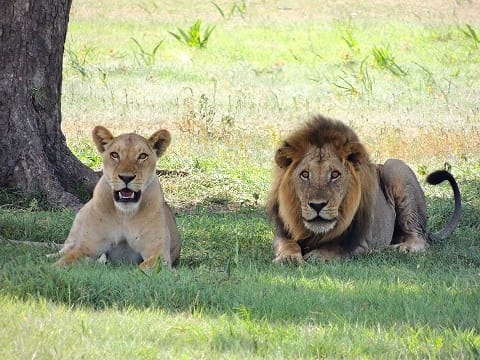Celebrating World Wildlife Day, March 3, 2022, African countries marked the day through activities touching the conservation and protection of wild animals across the continent. Bearing the theme of “Recovering key species for ecosystem restoration,” the 2022 World Wildlife Day seeks to raise awareness of the critically endangered species of flora and fauna in ecosystems with a view to generating and implementing workable solutions to conserve them
In Tanzania, militarization of wildlife and nature conservation has increased the number of wild animals living in protected and open areas over the past 3 to 4 years. Looking to protect wildlife and forests from poachers, the government of Tanzania changed its conservation strategies from civilian to paramilitary, aiming to equip rangers and game wardens with military skills in combating poaching of wildlife and nature.
This departure from a civilian to paramilitary system by the conservation institutions seeks to protect natural resources from total depletion and to instill discipline among the staff, the Minister for Natural Resources and Tourism, Dr. Damas Ndumbaro, said. The minister said that paramilitary training was a mandatory requirement for all employees from wildlife and nature conservation units. He said that Tanzania has now opened doors for private wildlife keepers to be licensed for breeding specified wildlife species.
Paramilitary training involved key personnel in the Ministry of Natural Resources and Tourism and has transformed the mode of operation on the conservation of wildlife and forestry institutions from civilian to military, aiming to reinforce the anti-poaching drive. The establishment of the paramilitary force is the Tanzania government’s commitment to controlling poaching and depletion of natural resources, the minister said.
Introduction of paramilitary training for wildlife rangers and managers was necessitated by changes which poachers have been applying through high-tech communications and the application of military equipment to kill elephants and other endangered species. Paramilitary strategy has been equipped with modern and high-tech surveillance equipment to detect elephant poachers and other criminals operating inside Tanzania’s protected parks and unprotected open areas inhabited with wild animals.
Tanzania’s elephant population in 1960 was about 350,000, but their number was less than 60,000 heads last year, the latest conservation reports indicate. The London-based Environmental Investigation Agency (EIA) said in its report published last year that ivory seizures linked to Tanzania had dropped between 2015 and 2019 to less than 5 tons after the introduction of paramilitary conservation strategies and enforcement of laws to prosecute poaching syndicates. The EIA report quoted the 2020 wildlife census showing an increase of elephants in the Serengeti ecosystem from 6,087 in 2014 to about 7,061 in 2020 after the introduction of paramilitary strategies on wildlife conservation.
The success in reducing illegal poaching in the Serengeti ecosystem in Northern Tanzania was attributed to intensification of frequent patrols which had arrested about 5,609 poachers.
The minister said that the reinforcement of wildlife conservation in protecting grass-eating wild animals had increased the lion population due to availability of food for the predators. Tanzania has a large number of lions after the increase of funds (budget) for surveillance operations against poaching by at least 90 percent with an expectation to eradicate the killings and crime against wild animals by the year 2025.
The most recent and latest research findings released by wildlife conservation institutions have indicated an increase in the number of lions, mostly in protected parks and open game reserves. The United States (US) based Safari Club International (SCI) said in its report late in January that Tanzania is home to more than half of all lions living in the world. SCI President Sven Lindqueast said at the 50th Conference of Tourist Hunters in Las Vegas in USA late in January this year that reinforcement of wildlife conservation strategies has resulted in the increase of lions, making Tanzania the breeding ground for more than 50 percent (50%) of all lions living in the world.
Researchers have estimated that more than 16,000 lions are living in Tanzania, mostly in protected wildlife parks including the national parks and game reserves, while quite a large number of others are living in open game areas outside the wildlife protected land. Some lions are living a migratory life, roaming between Tanzania and neighboring regional states through their natural corridors. There have been wildlife migrations between Tanzania, Kenya, Rwanda, and Mozambique through inter-territorial wildlife corridors.
The lion is considered the “King of the Beasts” with every tourist booked to visit Tanzania and East Africa looking to encounter with a lion before ending a trip in a wildlife park. Lions are the most sought animals by tourists visiting northern wildlife parks in Tanzania, thus supporting a sharp growth of the tourist industry, now attracting about 1.4 million tourists per year who are spending around US$2.4 billion.
Image courtesy of David Sluka from Pixabay
WHAT TO TAKE AWAY FROM THIS ARTICLE:
- SCI President Sven Lindqueast said at the 50th Conference of Tourist Hunters in Las Vegas in USA late in January this year that reinforcement of wildlife conservation strategies has resulted in the increase of lions, making Tanzania the breeding ground for more than 50 percent (50%) of all lions living in the world.
- Paramilitary training involved key personnel in the Ministry of Natural Resources and Tourism and has transformed the mode of operation on the conservation of wildlife and forestry institutions from civilian to military, aiming to reinforce the anti-poaching drive.
- The EIA report quoted the 2020 wildlife census showing an increase of elephants in the Serengeti ecosystem from 6,087 in 2014 to about 7,061 in 2020 after the introduction of paramilitary strategies on wildlife conservation.






















